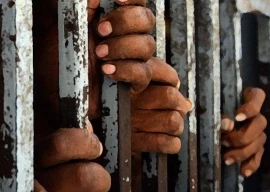
It was to be another three years before Eman’s family found out about the Umeed Special Trust in Sher Shah. The trust guided the family to the ALC where Eman got her first artificial leg, and was finally able to attend school. She is now back at the ALC for another leg to fit her growing body.
Stories like Eman’s play out daily at the ALC. Over 5,000 patients have been provided free limbs, which would otherwise cost between Rs 30,000 and Rs 100,000 each.
A collaborative venture by Health and Social Welfare Association (HASWA) and Rotary Club Karachi, ALC started to provide fully functional artificial limbs, free of charge, to people in July 2008.
“When we got a patient who had lost a limb in a bomb blast and we couldn’t get a limb for her, I realised that no institute in Pakistan trains people on how to make limbs,” says Dr Feroz Ismail, the founder and director of HASWA. “In 2007, the Rotary Club invited a team of 18 specialists from Jaipur Foot, the largest organisation in the world for artificial limbs, to set up a 15-day camp at Dow University to provide limbs to amputees. The response was overwhelming. Thousands of patients turned up — we couldn’t possibly treat them all. We also realised that this was not camp-level work: after three years of wearing a prosthesis, all artificial legs need repairs, no matter what. Moreover, growing children continuously need new legs. Therefore, we decided upon a life-long commitment to providing support.”
Despite its low-key operations, patients from all over the country come to the ALC. Paras, 16, who has been handicapped since birth, travelled all the way from Dadu with her brother to get an artificial leg at the camp in 2007. Four years on, she has come to the ALC to get her excessively used leg replaced with one that matches her new height. “Previously, I couldn’t stand for long or work in the kitchen,” she says, reflecting upon the change that a second leg has brought in her life. “But this is not an issue anymore.”
“For people in remote areas,” says Dr Ismail, “waking up one morning and coming to a city to get a new leg, is a miracle in itself.”
Since its inception, ALC has kept a record of every person who has been given a free limb at the centre. However, nothing would have been possible without private donors such as Asif Rangoonwala and organisations like the Rotary International that committed to providing financial support from day one. For six months, new recruits were trained by technicians from Jaipur Foot in India. Since then, Jaipur Foot has regularly sold supplies and helped whenever required.
“Initially everything came from India,” says Dr Ismail. “However, now we are starting our own developmental procedures in order to be less dependent.”
ALC aims to provide patients with their missing legs on the very day that they arrive at the centre. If, on a certain day, there is an influx of patients from both interior Sindh and Karachi, the patients from the interior are treated first so that no one has to stay the night in the city. Moreover, ALC often pays their rickshaw or taxi fares since patients from the interior often cannot afford two-way fares. “We only make a patient spend two rupees,” says Azfar Zaidi. “And that is to get their NIC photocopied for our records.”
If a patient comes from Punjab or Sukkur, he is sent back with tools with which he can solve small issues like the loosening of the socket, with assistance over the phone.
Although the workers at ALC are paid well, money isn’t the motivating factor. Despite knowing that there is no pay for overtime work, employees often stay late to help patients. Farzana, the senior technician at ALC, admits she still gets teary-eyed when she sees patients. “When I came to work here, I understood the problems of people for the first time,” she says.
All the workers are united by the common vision of putting a smile on the sad faces of the people who daily limp into the ALC. When Azfar Zaidi, who seemed to be the most familiar with the centre and its patients, was asked about his designation, he clarified that there was no such concept at ALC. “Call me a clerk or a manager,” says Zaidi. “If we get into designations, we won’t get any work done.”
The limbs are made after a simple procedure: a staff member takes the patient’s measurements and makes a mould. The cast is then filled with plaster of Paris and covered with a rubber soft pipe. A prosthetic foot with rubber soles is then attached to the prosthetic leg. “These legs are much more durable than the ones made in China,” explains Zaidi pointing towards a torn China-manufactured foot.
When Dr Ismail was asked why he doesn’t advertise the centre, he responded by saying that they don’t want to be overwhelmed with patients — which has happened in the past. ALC keeps a stock of prostheses for 7 to 8 months and relies on donors for their running expenses. Advertisement would make ALC risk running out of resources and turning down hopeful patients. “Maybe if a big donor is willing to step in, we could expand upon this project,” says Dr Ismail.
Even though there is no regular system of donors, Zaidi is confident that ALC will not run out of donations. “When you believe in Allah, you have to understand that He will keep the wheels turning,” he says. “In three years, we have not had to stop work even for a day. Even when security conditions in Gulistan-e-Jauhar are bad, our location stays safe.”
One of the staffers tells us that ALC once provided a beggar with a prosthetic limb, and he quit begging and started a fruit stall despite the fact that he earned more money while begging.
“When a man loses his limb, he loses his income, family, relatives and dignity,” says Dr Ismail. “We give him back his dignity but this is not a favour to them. As a Muslim, I have to fulfil Huqooq-ul-Ibad (rights of the people). If God made me a doctor and gave me two legs, then it is a patient’s right over me that I get him two legs.”
Published in The Express Tribune, Sunday Magazine, September 4th, 2011.


1725443747-0/Untitled-design-(5)1725443747-0-165x106.webp)














COMMENTS (1)
Comments are moderated and generally will be posted if they are on-topic and not abusive.
For more information, please see our Comments FAQ